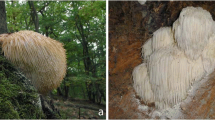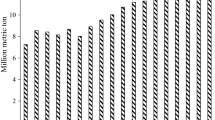Abstract
Astragali Radix is a widely and commonly used Chinese herbal medicine, which is derived from roots of Astragalus membranaceus var. mongholicus and Astragalus membranaceus. To find a quick and reliable method of distinguishing these two species of Astragali Radix and of determining the age of a sample, microscopic characteristics of the two species were compared using light microscopy. The results showed that the microscopic characteristics, such as number of layers of phellem, continuing lignified xylem bundles within spring wood and lignified parenchyma cells in the central part of the xylem could be used for the differentiation of the root of A. membranaceus from the root of A. membranaceus var. mongholicus. Growth rings (annual rings) were found for the first time in the roots of both species, and could determine the age of a sample. For the first time, radial fibers in both species of Astragali Radix and pipette-shaped fibers in A. membranaceus var. mongholicus were found. The structure of “rotten heart” cork tissue (decayed central xylem) and tubular cork tissue was carefully studied, and the arranged order of tissues in both “rotten heart” and tubular cork tissues is phelloderm and phellem from outside to inside, which is contrary to that in the periderm.




Similar content being viewed by others
References
Tang SW (1970) Chinese herbal of Takwan (Daguan Bencao), Sung (Song Dynasty), compiled by Dr. Kimura and Dr. Masao Yosizaki with New Index. Hirokawa Publishing Company, Tokyo, pp 182–183
The State Pharmacopoeia Committee of China (2010) Pharmacopoeia of the People’s Republic of China, vol 1. China Medical Science Press, Beijing. pp 283–284. Addenda, pp 108–109
Sinclair S (1998) Chinese herbs: a clinical review of Astragalus, Ligusticum, and Schizandrae. Altern Med Rev 3:338–344
Shon YH, Kim JH, Nam KS (2002) Effect of Astragali Radix extract on lipopolysaccharide-induced inflammation in human amnion. Biol Pharm Bull 25:77–80
Toda S, Shirataki Y (1999) Inhibitory effects of Astragali Radix, crude drug in oriental medicines on lipid peroxidation and protein oxidative modification of mouse brain homogenate by copper. J Ethnopharmacol 68:331–333
Ma J, Peng A, Lin S (1998) Mechanisms of the therapeutic effect of Astragalus membranaceus on sodium and water retention in experimental heart failure. Chin Med J 111:17–23
Wagner H, Bauer R, Xiao PG, Chen JM, Michler G (1997) Radix Astragali (Huang Qi). Chin Drug Monogra Anal 1:1–17
Wang BQ, He ZQ, Zhang J (1997) Species systematization and quality evaluation of commonly used Chinese traditional drugs, vol 2. Fujian Technology Press, Fuzhou, pp 148–183
Jiang Y, Jin F, Bao Z, Shi ZY, Tu PF (2006) Analysis astragaloside IV quantitation in Radix Astragali with different location and age. Chin J Chin Mater Med 31:930–933
Fu TJ, Li BG, Ji YQ (2000) Determination astragaloside IV quantitation in Radix Astragali injection by HPLC. Chin J Chin Mater Med 25:166–168
Lin LZ, He XG, Lindenmaier M (2000) Liquid chromatography-electrospray ionization mass spectrometry study of the flavonoids of the roots of Astragalus mongholicus and A. membranaceus. J Chromatogr A 876:87–95
Liu J, Chen HB, Bai YJ, Cai SQ, Gu HF, Guo HZ, Du XG (2008) Comparing quality of Heng-shan Radix Astragalus in different cultivated method. Chin J Chin Mater Med 33:570–572
Lou ZC, Wang X, Mikage M, Namba T (1989) Pharmacognostical studies on the Chinese Crude Drug Rhubarb IV, on the abnormal vascular system and coil-like vessels in the certain Rheum spp. J Jpn Bot 64:97–107
Cai SQ, Mikage M, Namba T (1989) Pharmacognostical studies on adiantum plants. IV. on Histotaxonomy of series veneri-capilliformia and the origins of related crude drugs. Shoyakugaku Zasshi 43:177–187
Wang X, Cai SQ, Lou ZC, Zhang JS, Zhao XY (1994) Macroscopical and microscopical studies on Chinese drug Baixianpi, root-bark of Dictamnus dasycarpus and its substitutes. J Chin Pharm Sci 3:110–119
Wang X, Zhang YH, Cai SQ, Chen HB, Li SH, Mikage M, Namba T (1998) Studies on identification of tougucao derived from clematis species. Chin J Chin Mater Med 23:198–203
Liang ZT, Jiang ZH, Leung KSY, Peng Y, Zhao ZZ (2006) Distinguishing the medicinal herb Oldenlandia diffusa from similar species of the same genus using fluorescence microscopy. Microsc Res Tech 69:277–282
Zhao ZZ, Hu YN, Wong YW, Wong WCG, Wu K, Jiang ZH, Kang TG (2005) Application of microscopy in authentication of Chinese patent medicine-Bo Ying compound. Microsc Res Tech 67:305–311
Li T, Zhang H (2008) Application of microscopy in authentication of traditional Tibetan medicinal plants of five Rhodiola (Crassulaceae) Alpine species by comparative anatomy and micromorphology. Microsc Res Tech 71:448–459
Yang DY, Cai SQ, Wang X, Yang WL, Tani T, Yamaji S, Namba T (2005) Study on identification of wild and cultivated Radix Scutellariae in different growing years. Chin J Chin Mater Med 30:1728–1735
Liu YB, Zhang QB (2007) Growth rings of roots in perennial forbs in Duolun Grassland, Inner Mongolia, China. J Integr Plant Biol 49:144–149
Feng YX, Shiao PG, Lou TC, Cheng CY (1964) The botanical and pharmacognostical studies of the Chinese drug Huang-Ch’I. II. Morphology and histology of Huang-Ch’I and Hung-Ch’I. Acta Pharm Sin 11:179–188
Li M, Qin XQ, Chen SB, Feng YX (1994) Morphological and microscopical identification of genus Astragalus on mainly used commercial Huang qi. Acta Pharm Sin 29:862–871
Author information
Authors and Affiliations
Corresponding authors
Electronic supplementary material
Below is the link to the electronic supplementary material.
Rights and permissions
About this article
Cite this article
Yu, KZ., Liu, J., Guo, BL. et al. Microscopic research on a multi-source traditional Chinese medicine, Astragali Radix. J Nat Med 68, 340–350 (2014). https://doi.org/10.1007/s11418-013-0802-z
Received:
Accepted:
Published:
Issue Date:
DOI: https://doi.org/10.1007/s11418-013-0802-z




